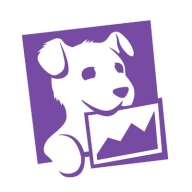

Datadog and Google Cloud's operations suite (formerly Stackdriver) compete in the cloud monitoring space. Datadog holds an edge in user satisfaction due to its features and ease of use, while Google Cloud excels in seamless integration within Google's ecosystem.
Features: Datadog offers intuitive dashboards, diverse integrations, and a comprehensive monitoring setup. Its dashboards allow for easy visualization and analysis, while diverse integrations ensure compatibility with multiple platforms. Google Cloud's operations suite provides strong cloud integration, particularly within the Google ecosystem, but it lacks the customization and extensive integration options of Datadog.
Room for Improvement: Datadog needs improvement in performance when accessing older data and desires for more granular control over dashboard sharing. The challenge of diverse API consistency and interface stability remains. Google Cloud's suite lacks detailed application-level insights, hindering error traceability. Enhancements in logging capabilities and response time breakdowns are also needed.
Ease of Deployment and Customer Service: Datadog supports flexible deployments in private, public, and hybrid environments, backed by excellent customer service and responsive technical support. Google Cloud's operations suite benefits from tight integration with Google services and provides strong deployment capability, but technical support varies in speed and thoroughness.
Pricing and ROI: Datadog's pricing is perceived as high with complexities in pricing structure and potential unexpected costs. Yet, users find the cost reasonable due to the enhanced visibility and operational advantages. Google Cloud's operations suite offers good value within the Google ecosystem but may lack detailed insights, impacting perceived ROI despite competitive pricing.


Datadog is a comprehensive cloud monitoring platform designed to track performance, availability, and log aggregation for cloud resources like AWS, ECS, and Kubernetes. It offers robust tools for creating dashboards, observing user behavior, alerting, telemetry, security monitoring, and synthetic testing.
Datadog supports full observability across cloud providers and environments, enabling troubleshooting, error detection, and performance analysis to maintain system reliability. It offers detailed visualization of servers, integrates seamlessly with cloud providers like AWS, and provides powerful out-of-the-box dashboards and log analytics. Despite its strengths, users often note the need for better integration with other solutions and improved application-level insights. Common challenges include a complex pricing model, setup difficulties, and navigation issues. Users frequently mention the need for clearer documentation, faster loading times, enhanced error traceability, and better log management.
What are the key features of Datadog?
What benefits and ROI should users look for in reviews?
Datadog is implemented across different industries, from tech companies monitoring cloud applications to finance sectors ensuring transactional systems' performance. E-commerce platforms use Datadog to track and visualize user behavior and system health, while healthcare organizations utilize it for maintaining secure, compliant environments. Every implementation assists teams in customizing monitoring solutions specific to their industry's requirements.
Real-time log management and analysis
Cloud Logging is a fully managed service that performs at scale and can ingest application and platform log data, as well as custom log data from GKE environments, VMs, and other services inside and outside of Google Cloud. Get advanced performance, troubleshooting, security, and business insights with Log Analytics, integrating the power of BigQuery into Cloud Logging.
Built-in metrics observability at scale
Cloud Monitoring provides visibility into the performance, uptime, and overall health of cloud-powered applications. Collect metrics, events, and metadata from Google Cloud services, hosted uptime probes, application instrumentation, and a variety of common application components. Visualize this data on charts and dashboards and create alerts so you are notified when metrics are outside of expected ranges.
Stand-alone managed service for running and scaling Prometheus
Managed Service for Prometheus is a fully managed Prometheus-compatible monitoring solution, built on top of the same globally scalable data store as Cloud Monitoring. Keep your existing visualization, analysis, and alerting services, as this data can be queried with PromQL or Cloud Monitoring.
Monitor and improve your application's performance
Application Performance Management (APM) combines the monitoring and troubleshooting capabilities of Cloud Logging and Cloud Monitoring with Cloud Trace and Cloud Profiler to help you reduce latency and cost so you can run more efficient applications.
We monitor all Application Performance Monitoring (APM) and Observability reviews to prevent fraudulent reviews and keep review quality high. We do not post reviews by company employees or direct competitors. We validate each review for authenticity via cross-reference with LinkedIn, and personal follow-up with the reviewer when necessary.